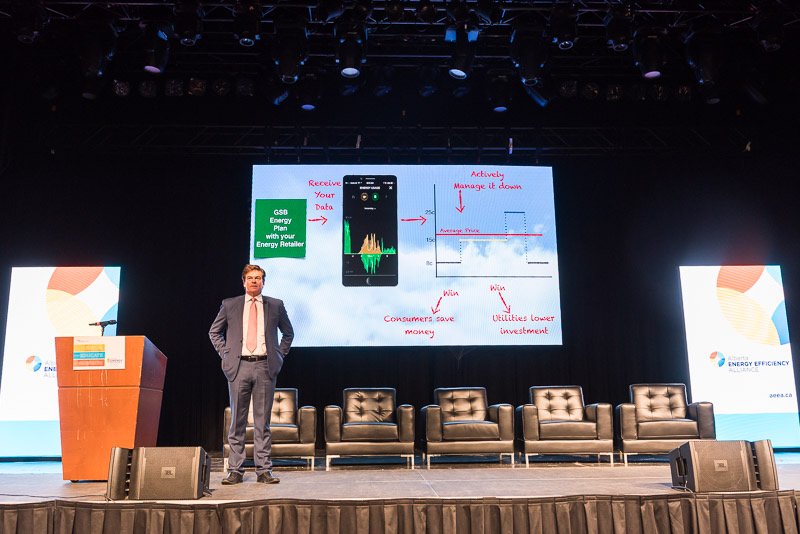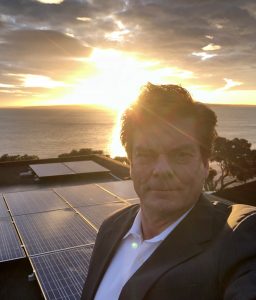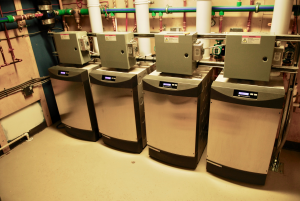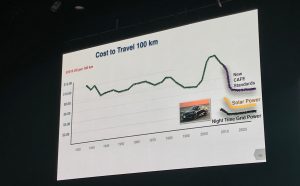By David Dodge and Scott Rollans
If you listen to a former ENMAX CEO, Alberta could learn a key lesson from New Zealand when it comes to pricing electricity. Gary Holden now runs Pulse Energy in Aukland, NZ, where “time-of-use” billing has helped spark a boom in solar systems paired with batteries.
“We’ve structured an energy contract so consumers can get solar power, get a battery, and buy the remaining grid power from us— all for the same price,” Holden explains.
In Alberta, fixed and non-energy charges make up a whopping 58 per cent of our electricity bills. This distorts the market because we all pay a fixed share of these costs—regardless of how energy-efficient we are, or what time of day we use electricity.
Half of New Zealand’s electricity distributors have done away with fixed charges for distribution and transmission, absorbing those costs into the variable time-of-use pricing. “It’s establishing a price for power during the day, a price for power again in the evening, and a price for power during the night,” says Holden.
By matching price more closely with demand, time-of-use pricing improves the economics of combining solar power with battery systems and electric cars. Batteries allow customers to avoid high-priced electricity in the daytime, and to draw more electricity during lower-cost times of day.
Solar-battery business is economic and booming
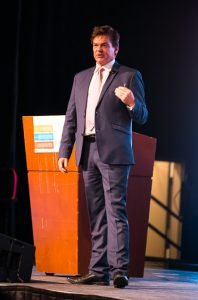
Gary Holden speaking at the Alberta Energy Efficiency Alliance meeting in Calgary in 2018. Photo AEEA
As word has gotten around, demand has exploded. Pulse currently installs 250 solar-battery systems every month. Demand would be even higher, says Holden, but half of Pulse’s customers don’t have the right roofing for solar. “So, those default to what we call our 100 percent renewable grid contract.”
The cost of distribution and transmission has soared in recent years. In a system with fixed charges, this perversely reduces the incentive to conserve electricity. “It’s funny: in Alberta, frugal users pay the most,” Holden says. “It just doesn’t make sense. It will be like if you’d have a hybrid car and you pulled up to a gas station or a gas station, and because you had a hydro hybrid car you’d pay more.”
Why have prices skyrocketed in the last 15 to 20 years?
Why have those fixed charges risen? “The answer is almost exclusively because of the infrastructure part—the transmission and distribution part—…are using depreciated assets as their base.”
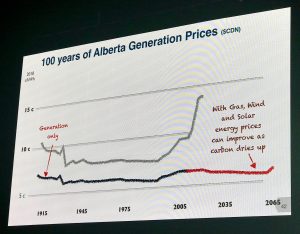
Transmission and distribution costs have skyrocketed, while generation has remained constant. Slide from Gary Holden presentation
“If you’re an economist, that’s not really the right way to look at this. [Solar-battery] should be competing head to head with the new increment of the grid power—both the transmission and distribution, in addition to the energy itself. And when you do that comparison, solar power and batteries are vastly more economical—particularly where summer peaks are driving the overall capacity of the network.”
In other words, time-of-use allows small producers to compete with what it would otherwise cost to add new capacity to the grid.
This competition drives behavioural change. “It is fair to send price signals so that people do things in competition with the network. They put on solar panel panels, put in batteries, buy LED lights, buy electric cars. All these things are market responses to pricing.”
By converting all of those pesky fixed charges into variable charges, time-of-use pricing allows solar-battery consumers to profit more when they produce energy, and to save more when they conserve energy. “You no longer need a fixed charge, except maybe a charge for the meter,” Holden says.
Lessons learned
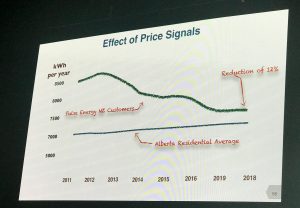
Time-of-use encourages energy efficiency. Since implementing time-of-use pricing Pulse customers have reduced consumption by 12 per cent. Slide from Gary Holden presentation
It might seem very surprising to most of us, but solar with battery storage is already more than competitive when time-of-use pricing is implemented.
Even better, it can also reduce the need for expensive grid infrastructure. “Distribution and transmission pricing will actually drop over time. Solar panels are always getting cheaper, batteries are getting cheaper and so the green energy market for electricity actually is going to get cheaper—and that’s going be good news for any policymaker,” says Holden.
Holden says we’ve vastly underestimated just how fast solar can grow, and how quickly that transition can transform our grids and our lives.
Market disruption enroute
Because time-of-use pricing makes grid costs and prices transparent, technologies such as electric cars suddenly become a lot more appealing.
“I’ve been driving electric cars here for five years now,” says Holden. “And I worked out last year I went 10,000 kilometers on my BMW I3, and it cost me 150 bucks,” says Holden.
This is based on charging his car at night when electricity’s cheapest. “If consumers, right today, (start) choosing night-time energy to fill their cars, they are effectively buying oil at eight or nine bucks a barrel.”
Consumers are starting to pay attention. Holden says roughly 60 per cent of New Zealanders says their next car will be electric. Although a mass move to electric cars could strain the electrical grid, time-of-use pricing could mitigate this by encouraging people to charge when demand (and prices) are lowest.
The renewable energy revolution will disrupt traditional transmission and distribution strategies as well—which could be good news. If Holden is right, these new distributed energy technologies will make it cheaper to operate our grids. In turn, those savings should be reflected on your electricity bill.
In New Zealand. people like Holden have solar on their roofs, batteries in their homes, and electric cars in their garages—not out of virtue, but because it makes economic sense. Holden believes time-of-use pricing is the key to a lower-cost (and more sustainable) energy future.
